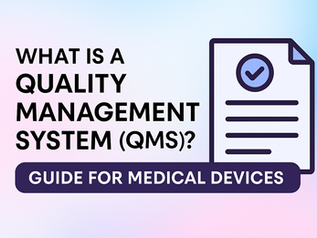top of page


Medical Device QMS (2025): ISO 13485 & FDA QMSR 2026 Guide
A medical device Quality Management System (QMS) proves you can consistently design, make, and support safe, effective devices. It's...
Aug 75 min read


Predetermined Change Control Plan (PCCP) for AI/ML-Enabled Devices: 2025 FDA Guide
A Predetermined Change Control Plan (PCCP) is FDA documentation that lets you pre-define specific AI/ML software changes—and the methods...
Aug 610 min read


FDA Consensus Standards for Medical Devices: US Declaration of Conformity Guide 2025
FDA consensus standards are voluntary international standards that FDA recognizes for medical device submissions. Companies can submit a...
Aug 68 min read


How To Bring A Medical Device To Market: 2025 Step-by-Step Guide
Medical device development runs from concept through design controls, verification and validation, clinical investigations when needed,...
Aug 510 min read


Medical Device Packaging Requirements: Complete FDA, ISO 11607 & Validation Guide 2025
FDA requires packaging that protects devices from alteration or damage through processing, storage, handling, and distribution ( 21 CFR...
Aug 47 min read


How Much Does It Cost to Bring a Medical Device to Market? 2025 Budget Guide
Medical device development costs vary by classification: Class I ($200K-$2M), Class II ($2M-$30M), and Class III ($5M-$119M+). Major expenses include clinical trials (40-60% of budget), regulatory activities (10-15%), manufacturing setup (15-25%), and commercialization (10-20%). Timeline spans 1-7 years depending on complexity and pathway. The #1 question every medtech entrepreneur asks: "How much funding do I actually need?" The answer depends on your device classification,
Aug 38 min read


Design Controls for Medical Devices (21 CFR 820.30): Complete FDA Guide 2025
FDA Design Controls under 21 CFR 820.30 are quality system requirements ensuring medical devices are designed to meet user needs and...
Jul 308 min read


What Is UDI? FDA's Unique Device Identification System Guide 2025
UDI is FDA’s Unique Device Identification system: most device labels and packages must carry a UDI in machine-readable (AIDC) and...
Jul 296 min read


FDA Complete Guide: Everything Medical Device Companies Need to Know 2025
The FDA’s Center for Devices and Radiological Health (CDRH) regulates medical devices in the United States. Devices reach the market via...
Jul 288 min read


Medical Device Clinical Trials: 2025 FDA Requirements, IDE & Evidence Guide
Medical device clinical trials are FDA-regulated clinical investigations conducted under 21 CFR 812 to collect safety and effectiveness...
Jul 2311 min read


21 CFR 820 QSR to QMSR: 2026 US Transition Guide
FDA is replacing 21 CFR 820 (Quality System Regulation) with the Quality Management System Regulation (QMSR) on February 2, 2026,...
Jul 218 min read


FDA Medical Device Process: 2025 Pathway Guide
FDA authorizes medical devices via three pathways: 510(k) clearance for substantial equivalence, De Novo classification for novel low to moderate risk, and PMA (Pre-market) approval for most Class III devices. Under MDUFA V , FDA’s goals are 510(k): 95% within 90 FDA days , De Novo: 70% within 150 FDA days , and PMA average total time to decision ≈ 285 days in FY 2025–2027 . Your device's risk classification and predicate availability determine which pathway applies. This
Jul 217 min read


AI Medical Devices: FDA Draft Guidance, TPLC & PCCP Guide 2025
FDA AI medical device regulation received major updates with comprehensive draft guidance for artificial intelligence-enabled devices. On January 7, 2025 , FDA issued draft guidance for AI-enabled device software functions (DSF) that applies a Total Product Life Cycle (TPLC) approach. It recommends what to include in submissions: model description, data lineage/splits, performance tied to claims, bias analysis/mitigation, human-AI workflow, monitoring, and—if you’ll updat
Jul 2010 min read


ISO 14971:2019 Risk Management for Medical Devices: 2025 Implementation Guide
ISO 14971:2019 is the international standard that defines the lifecycle risk-management process for medical devices (including SaMD):...
Jul 1710 min read


FDA Medical Device Classification: Class I, II, III Explained (2025)
FDA medical device classification determines the regulatory controls required for your device based on risk level. FDA classifies devices...
Jul 156 min read


FDA Cybersecurity Compliance Standards: 2025 Complete Guide
FDA's new cybersecurity compliance standards carry criminal penalties and RTA threats that can destroy medical device companies. With the...
Jul 148 min read


FDA Cleared vs FDA Approved vs FDA Granted: 2025 Complete Guide
In FDA device speak, cleared ≠ approved ≠ granted. Mixing these terms can misbrand your product. FDA cleared means 510(k) approval for...
Jul 117 min read


What Is FDA STeP Program (Safer Technologies Program)? Complete Guide 2025
FDA's Safer Technologies Program (STeP) is a voluntary program for devices reasonably expected to significantly improve safety of...
Jul 107 min read


What Is an SBOM? FDA Requirements for Medical Devices (2025 Guide)
A Software Bill of Materials (SBOM) is a machine-readable inventory of every software component in your device—proprietary, OTS, and...
Jul 99 min read


What Is cGMP for Medical Devices? QSR Today, QMSR in 2026
In FDA device world, “ cGMP ” obligations are implemented via the Quality System Regulation (21 CFR 820) . On Feb 2, 2026 , FDA’s Quality...
Jul 97 min read
bottom of page
